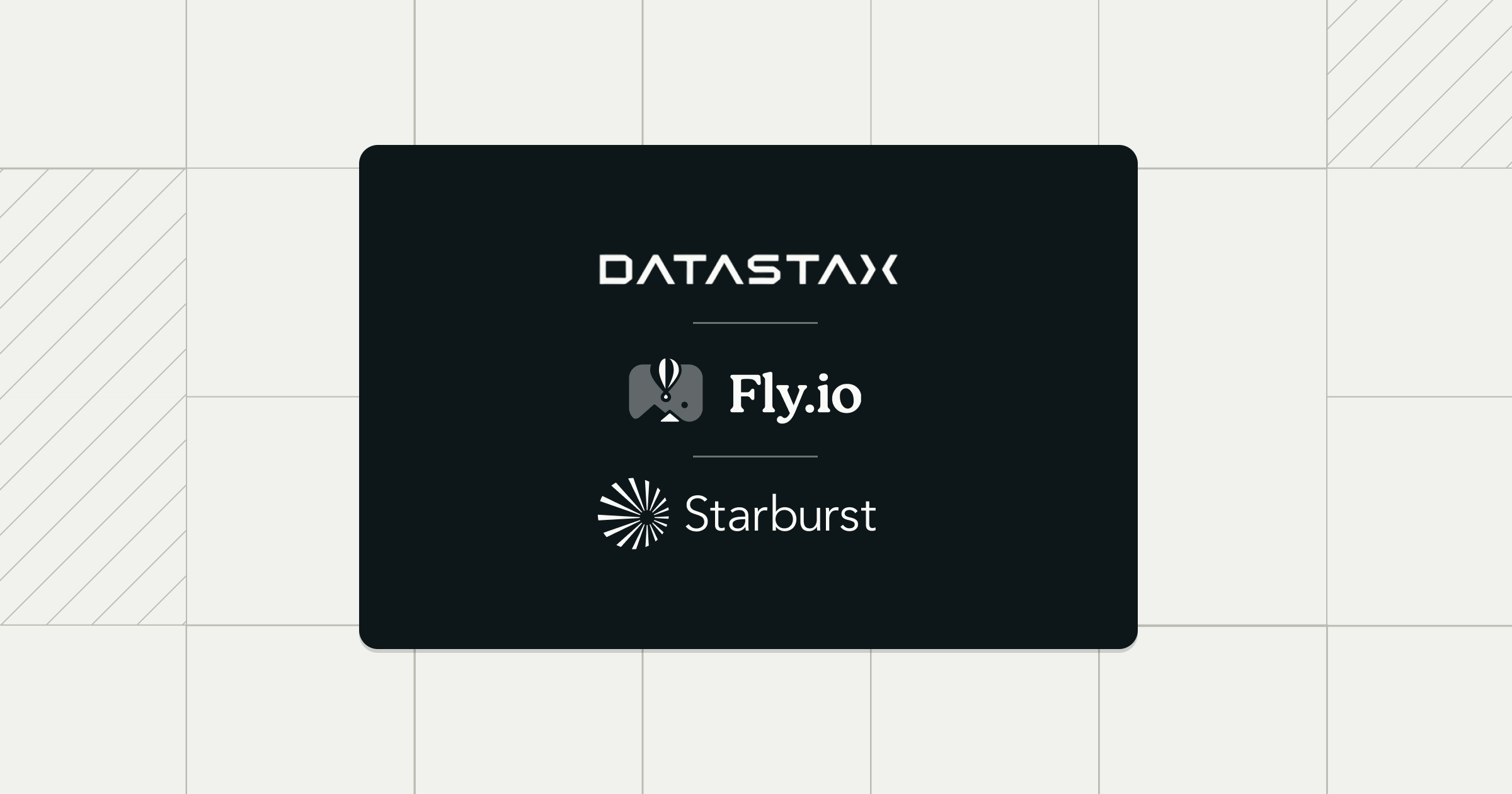Share
Three enterprise companies, three different industries, one shared discovery: traditional billing infrastructure breaks when pricing needs to evolve as fast as your product.
DataStax provides database-as-a-service for enterprise applications. Fly.io runs containerized applications at global edge locations. Starburst delivers analytics platforms for data lakehouse architectures. Each company operates in different markets with different customer bases, but they all hit the same wall: legacy billing systems that couldn't keep pace with product innovation.
Their experiences reveal five essential lessons about building pricing infrastructure that supports business growth rather than constraining it. Modern pricing infrastructure must enable rapid iteration, handle complex hybrid models, and provide real-time transparency that builds customer trust.
1. Legacy billing infrastructure creates operational friction at scale
Growth exposes billing system failures exactly when you can't afford downtime. Every pricing decision becomes a code deployment, every discount requires engineering tickets, and every customer question about usage triggers manual scripts.
DataStax felt this pain acutely. Their home-grown stack, Stripe plus custom logic, created 1,200+ SKUs. Each one of these was a brittle combination of product, region, and cloud provider. Tracking prepaid enterprise credits meant stitching together fragile account hierarchies.
Customers also had no window into real-time usage, so basic "How much have we spent?" questions generated support tickets and manual reconciliation work.
"Even simple pricing adjustments required engineering to make hard-coded changes," the team recalls. Audits meant hunting through old code releases to prove when discounts went live. Manual reconciliations, revenue leakage, and compliance gaps followed until the company adopted Metronome as their billing platform. The migration eliminated "immense coordination required across 50+ cross-functional team members to implement workarounds," freeing engineers to focus on product development rather than billing firefights.
Even though Fly.io and Starburst have different business models, they hit the same operational walls.
Fly.io's developer-focused infrastructure requires rapid SKU updates to support region-aware, pay-as-you-go pricing with per-second metering and instant rate changes.
Legacy systems rarely automate these workflows, forcing engineering teams into multi-sprint billing projects for basic pricing updates.
And Starburst's shift from license-based pricing to consumption metrics like terabyte-seconds exposed similar rigidity. Legacy stacks optimized for simple subscription invoices struggle when asked to meter real-time analytics workloads, creating revenue delays and manual credit adjustments.
The pattern across all three companies reinforce the reality that every workaround adds technical debt. Engineers spend cycles reconciling invoices instead of shipping features. Finance teams chase missing usage data. Product managers postpone launches because pricing logic lives in production code.
This operational drag shows up externally too, customers face opaque bills and little or no visibility into their usage and spend until after a billing period ends. Legacy infrastructure doesn't just slow internal teams; it prevents you from offering the transparent, flexible pricing that modern buyers expect.
And that only gets more complex when you introduce multiple pricing models to the mix.
2. Multiple pricing models require infrastructure, not spreadsheets
Legacy systems were built for a single way of charging, usually a flat subscription. The moment your product delivers value through different dimensions, you need pricing elements that react to changes in those dimensions independently. The three case studies demonstrate this well.
Fly.io begins with a generous free allowance, then charges by the second for CPU, RAM, storage, and bandwidth. Because resources can be spun up in any region, the company maintains a centralized rate card that supports dimensional pricing by region, enabling teams to roll out region-specific rate changes without engineering effort. The company's billing dashboard translates live usage data into up-to-date spend totals, giving customers clear visibility throughout the billing cycle and helping avoid month-end surprises.
The billing dashboard needs to be updated continuously in near-real-time in order to be effective and to keep the customer feeling informed.
Starburst faced a different challenge. Traditional node-based licenses couldn't keep pace with cloud customers who scale analytics up and down each day. So Starburst Galaxy adopted a usage-based pricing model with universal compute credits, charging customers only for actual compute consumption rather than fixed capacity, enabling a frictionless self-serve experience that aligns with product-led growth. A self-serve portal gives customers visibility into metered activity and their credit burn-down, giving finance teams the predictability they need while letting engineers burst capacity on demand. This would be intensely labor heavy to update and monitor using spreadsheets.
DataStax supports multiple pricing and packaging models: a free tier that includes $25 of usage, on-demand Pay-As-You-Go rates for reads, writes, and storage, and custom enterprise contracts for high-commit customers. Before refactoring their pricing systems, even a minor SKU tweak required hard-coded changes; today the company can make pricing updates in days rather than weeks.
Spreadsheets and basic payment gateways just end up collapsing under the weight of hundreds of concurrent variables. Modern pricing infrastructure must centralize your pricing on rate cards that apply simultaneously across regions, products, and customer segments.
It needs to meter usage in real time and aggregate it at whatever time scale – per second, per query, per operation – matches how customers realize value. Most critically, it must sync that metered data into finance, sales, and customer dashboards without time-intensive and manual workarounds.
Without these capabilities, you face mounting maintenance effort, error-prone billing runs, and delayed revenue recognition. The bottleneck isn't deciding what to charge, it's having infrastructure that lets you change the model tomorrow without rewriting code or rebuilding spreadsheets -- and do it all in real-time.
3. Real-time usage visibility becomes a competitive advantage
When customers can track spend as it accrues, billing stops feeling like a black box and starts reinforcing trust. Usage-based models depend on this transparency to reduce churn, prevent end-of-month surprises, and give customers the insight they need to optimize their usage before the invoice arrives.
Fly.io's pricing complexity makes it challenging to give customers real-time pricing visibility. Each of their customers customer signs up as at least one organization that can run hundreds of apps across multiple regions, with charges based on machine type, CPU count, bandwidth, data transfer, and volumes. This means an invoice can end up with thousands of line items, leaving customers confused about where their money went. Add special contract pricing, regional discounts, and Fly.io's need to iterate quickly on pricing models, and traditional billing systems simply can't provide the transparent, real-time experience customers need. That's where Metornome comes in. Metronome's customer-centric billing features enabled Fly.io to maintain their granular per-resource pricing while giving customers the visibility and predictability they demand.
Instead of waiting thirty days for a bill, you watch costs accumulate hour by hour, making it simple to kill an idle VM or downsize storage before spend balloons.
Starburst applies the same principle to analytics workloads that can spike unpredictably. In Starburst Galaxy, administrators monitor query counts, bytes scanned, and credit burn in real time, then tie that consumption to business domains through integrations with partners like DataGalaxy. Data teams see which workloads drive costs, helping them justify cloud spend internally and tune compute before hitting budget ceilings.
DataStax embeds usage visibility directly in Astra DB. Dashboards surface consumed storage, read/write operations, and network egress, while Metronome handles the real-time metering. Because the billing platform aggregates usage continuously, finance, support, and customers all reference the same live data, eliminating the "open a ticket and wait for engineering to run a script" pattern that plagued their legacy system.
Real-time visibility delivers three tangible advantages: it prevents bill shock by letting users react to spikes immediately, lowers support load because answers live in the dashboard rather than the help queue, and creates a differentiated buying experience where prospects choosing between similar platforms gravitate toward the one that feels safer and more predictable.
In crowded markets where feature parity is common, financial control becomes a deciding factor.
Companies that surface live cost data transform billing from a compliance necessity into competitive infrastructure, a new way for customers to build trust through data visibility
4. Cross-functional teams need unified data sources
Pricing decisions require input from various teams, including product, engineering, finance, sales, and customer success. Each contributes unique insights and demands, yet operating from different systems often breeds misalignment and inefficiency.
Product teams aim to launch pricing changes without engineering tickets, striving for agility in meeting market demands. Meanwhile, finance teams need accurate forecasting data rooted in real usage metrics to ensure budget predictability and compliance.
Sales teams need flexibility to offer enterprise discounts and structure custom contracts, demanding seamless cooperation with other departments.
Successful pricing stack modernization depends on unifying these disparate data sources into a single source of truth for monetization. This consolidation ensures that usage data, customer information, and billing metrics flow seamlessly between systems, eliminating the discrepancies that create friction between teams and lead to revenue leakage.
To achieve true data unification, best practices include establishing standardized data schemas across all pricing systems, implementing real-time data synchronization between billing, CRM, and analytics platforms, and creating unified dashboards that provide consistent metrics to all stakeholders. This approach ensures that product, finance, and sales teams work from the same accurate data, reducing conflicts over revenue recognition, usage attribution, and customer health scores.
By eliminating data silos and ensuring everyone references the same data with the same level of accuracy, every pricing decision can be made with confidence and reduced risk of costly errors or customer disputes.
5. Pricing experimentation requires safe infrastructure
Pricing changes become engineering emergencies when your billing system treats every adjustment like a code deployment. Teams avoid necessary pricing updates because a single rate change requires coordinating across multiple services, extensive regression testing, and risky production releases.
When invoice errors or compliance failures become likely outcomes, organizations are reluctant to make frequent changes, which means your pricing gets stagnant and you miss revenue opportunities.
Legacy systems often tie pricing logic and product logic together, creating cascading dependencies that make simple experiments feel like major software releases. Rolling back failed tests becomes nearly impossible once invoices are generated, manual credits, customer confusion, and revenue recognition headaches follow.
This technical debt ends up creating a culture where pricing innovation grinds to a halt.
Safe experimentation infrastructure eliminates this friction by decoupling pricing logic from application deployments. A properly designed stack provides three core capabilities:
- Centralized rate card with modular pricing elements that maintains a single pricing source of truth while breaking down rigid plans into independent components, allowing easy modification of specific rates (like GPU costs or regional pricing) without recreating entire pricing structures or running migrations across thousands of active subscriptions
- Append-only versioning with effective date ranges that enables scheduled price changes, backdating, and instant global rollouts while preserving complete audit trails and the ability to reconstruct pricing at any point in time for compliance or reporting
- Instant rollback through configuration changes rather than code deployments, eliminating the need for engineering teams to write manual scripts or glue code for critical pricing operations
This approach transforms pricing from an operational hurdle requiring per-customer migrations and engineering involvement into a strategic growth lever that product and revenue operation teams can control directly. Changes deploy globally in minutes rather than days or weeks.
DataStax demonstrates this operational difference. Their most recent company-wide pricing overhaul required only three days from start to finish, with full auditability and zero manual invoice corrections. On their previous Stripe-based system, the same change demanded weeks of engineering effort and significant production risk.
With proper infrastructure, systematic experimentation becomes routine. A/B tests isolate single variables across carefully segmented cohorts. Phased rollouts measure churn, conversion, and lifetime value before scaling successful changes. Statistical significance replaces intuition in pricing decisions.
Companies with safe experimentation infrastructure iterate faster than competitors, discover actual customer price acceptance rather than assumptions, and respond to market shifts in days instead of quarters. The infrastructure investment recovers costs the moment the first successful test ships.
The modern pricing stack as competitive infrastructure
These three companies represent different scales and industries, but their experiences reveal a consistent pattern: pricing infrastructure determines competitive velocity. Companies that treat billing as operational infrastructure rather than technical debt can iterate faster, serve customers better, and scale more efficiently.
DataStax, Fly.io, and Starburst each faced the same constraint.
They had legacy billing systems that couldn't keep pace with product innovation and customer demands.
By investing in a modern billing system, they were able to transform pricing from an operational burden into a competitive advantage.
The modern pricing stack enables capabilities that weren't possible with traditional billing systems. Real-time usage metering that handles millions of events without latency issues. Flexible rate cards that support dimensional pricing across multiple variables. Customer-facing dashboards that provide transparency and spending control. Single source of truth that eliminate coordination overhead.
Most importantly, these systems enable super fast iteration and experimentation.
Pricing becomes a product that teams can optimize based on customer feedback, market conditions, and business performance. Instead of annual pricing reviews that delay market response, teams can test and deploy changes weekly or daily.
The competitive gap widens as AI and usage-based models become standard across software categories. Companies with modern pricing infrastructure can launch AI features with appropriate consumption-based pricing. They can respond to competitive moves within days rather than quarters. They can serve multiple market segments with customized pricing that matches customer procurement preferences.
Companies still managing pricing through spreadsheets and manual processes fall further behind as their competitors gain pricing agility. The infrastructure investment pays for itself through faster growth, higher customer satisfaction, and reduced operational overhead.
The learning to focus on? Pricing infrastructure becomes competitive infrastructure when it can be treated as rapid, responsive iteration rather than as a manual long-lead project. Modern companies succeed by building systems that scale this ability with complexity rather than get bogged down in legacy pricing processes.
{{widget-monetization-whitepaper}}










.png)